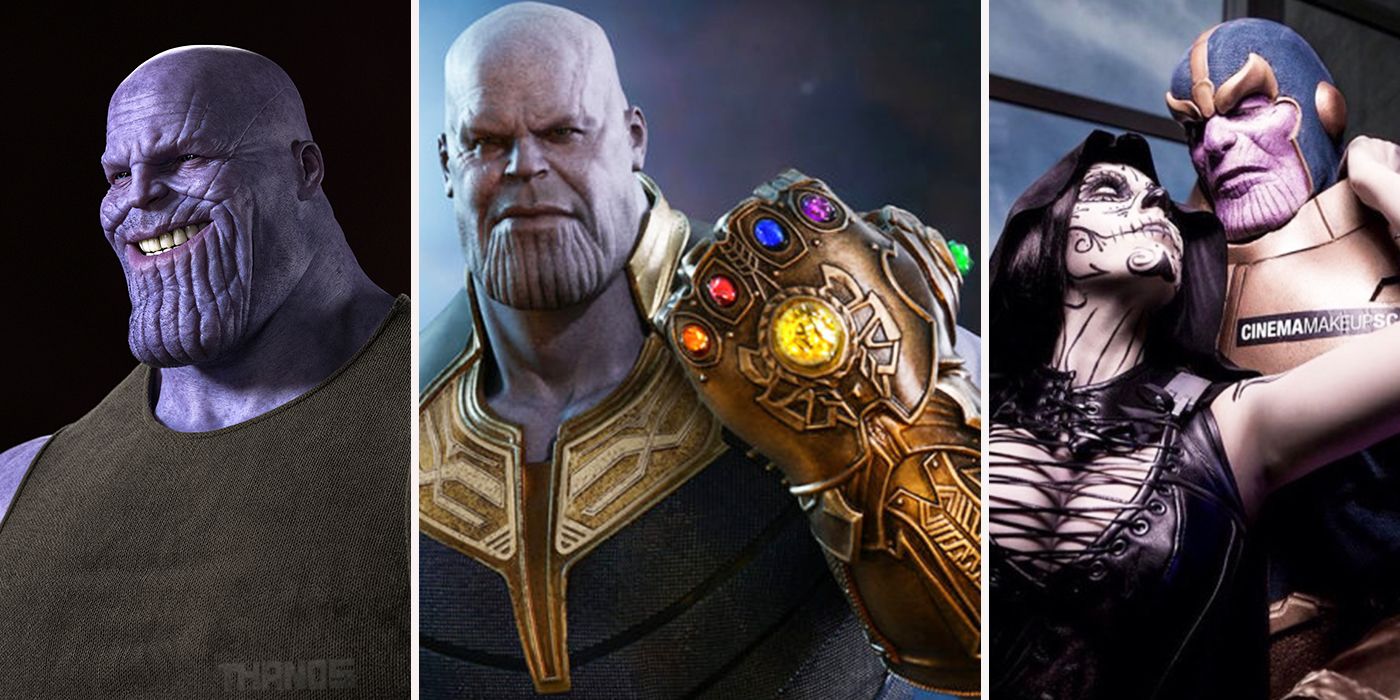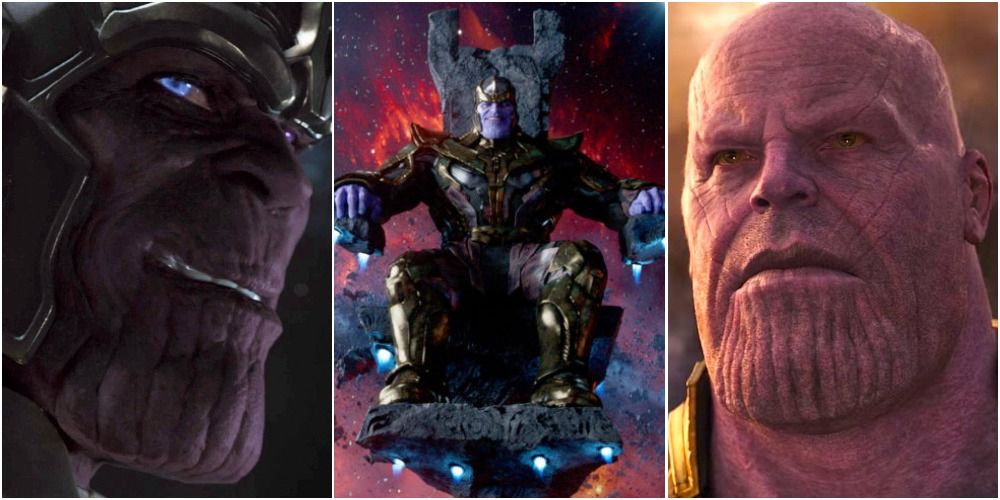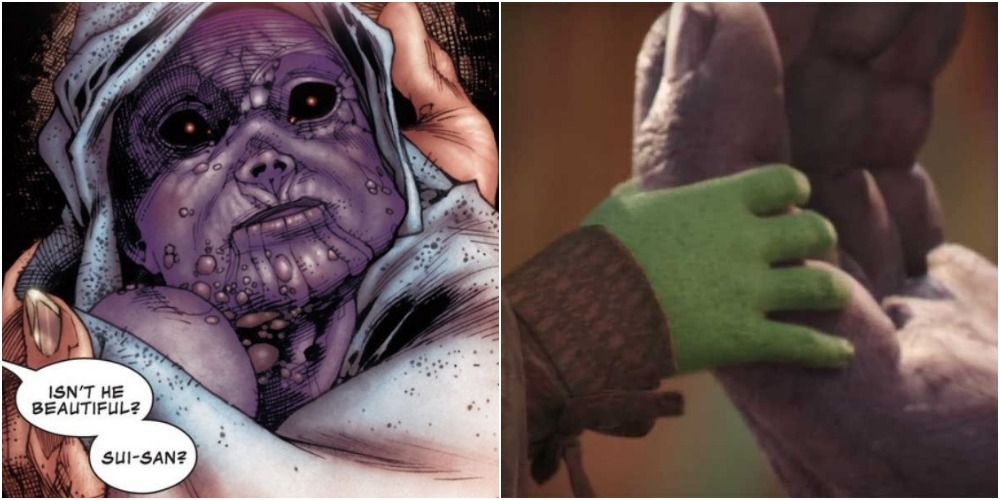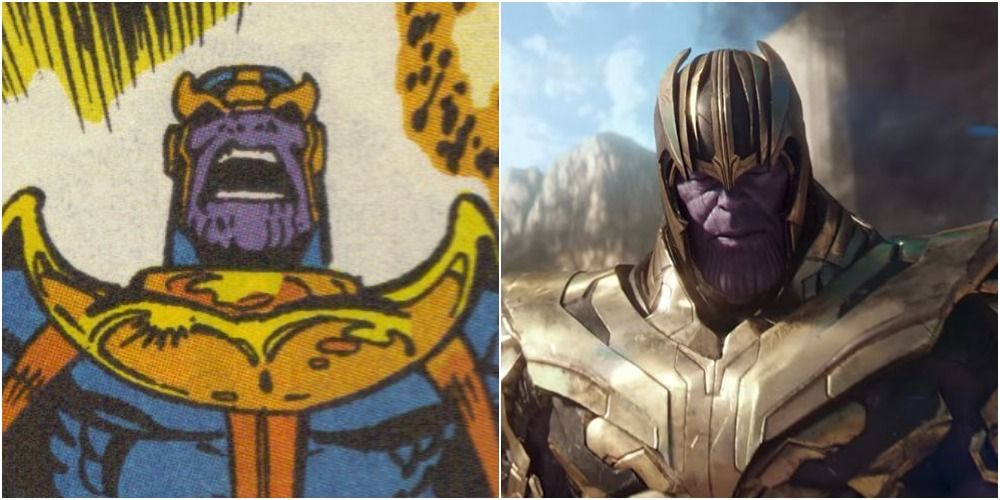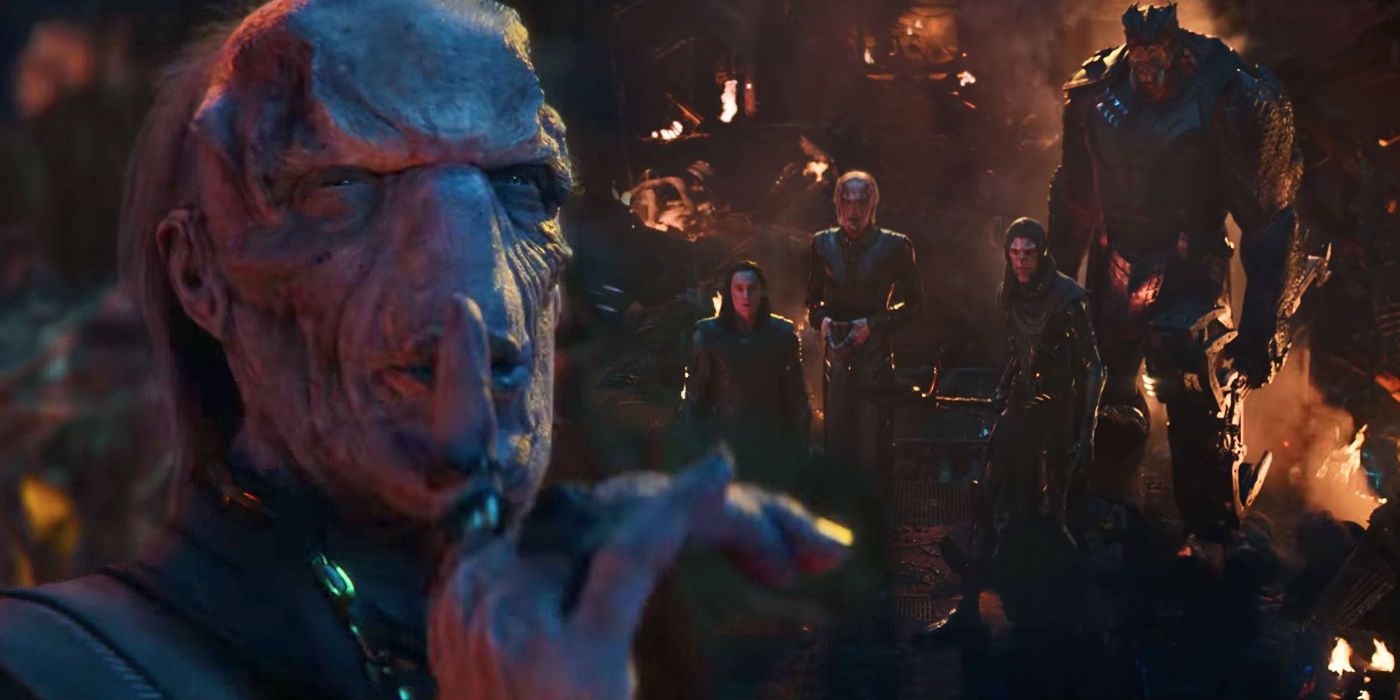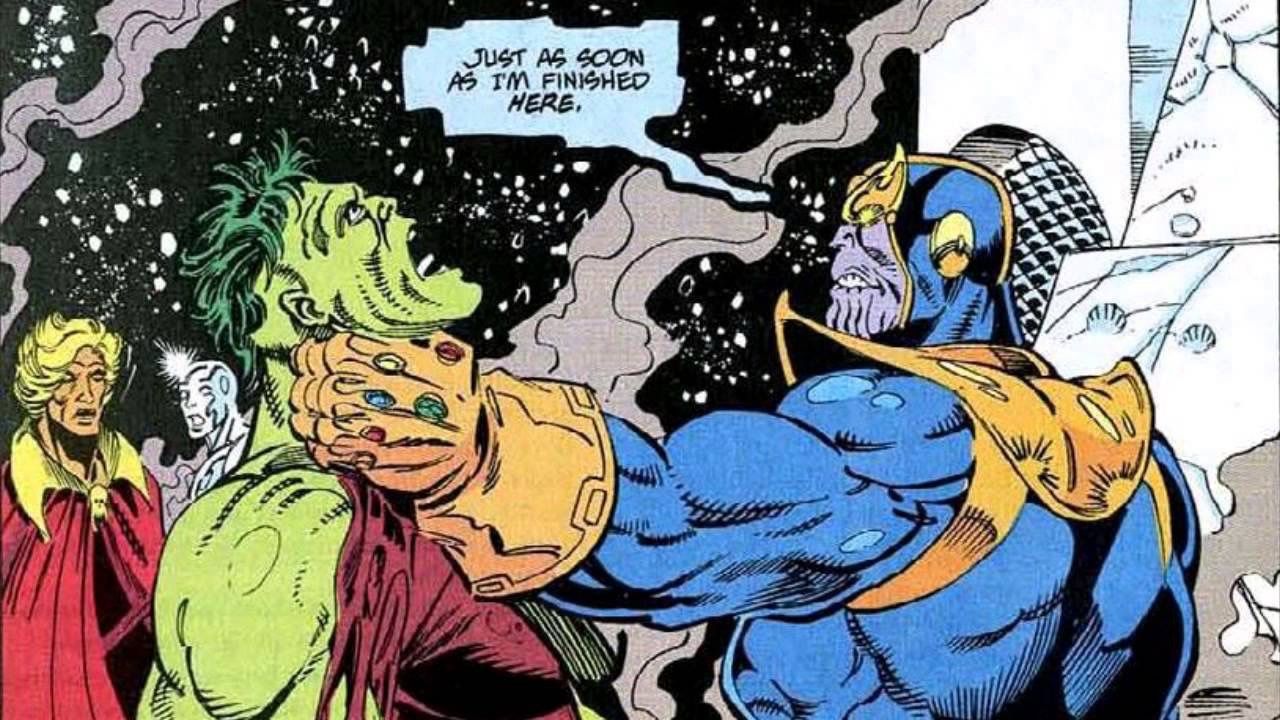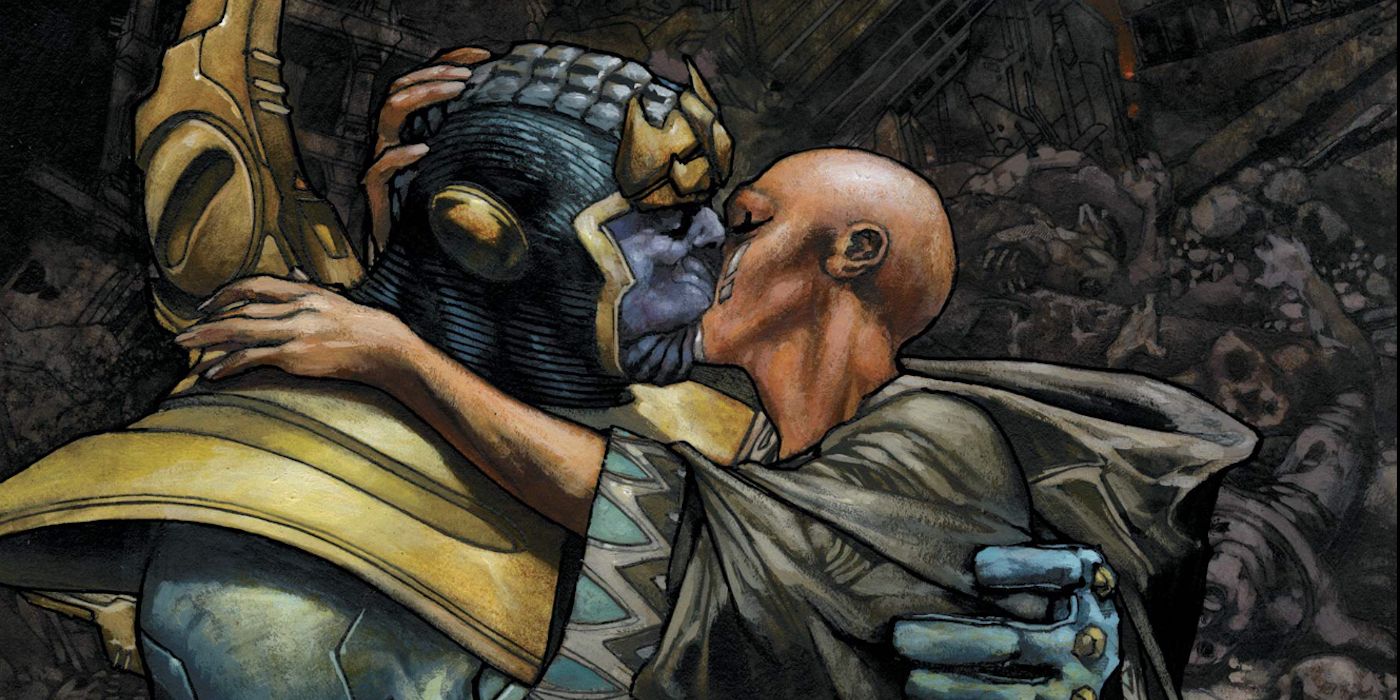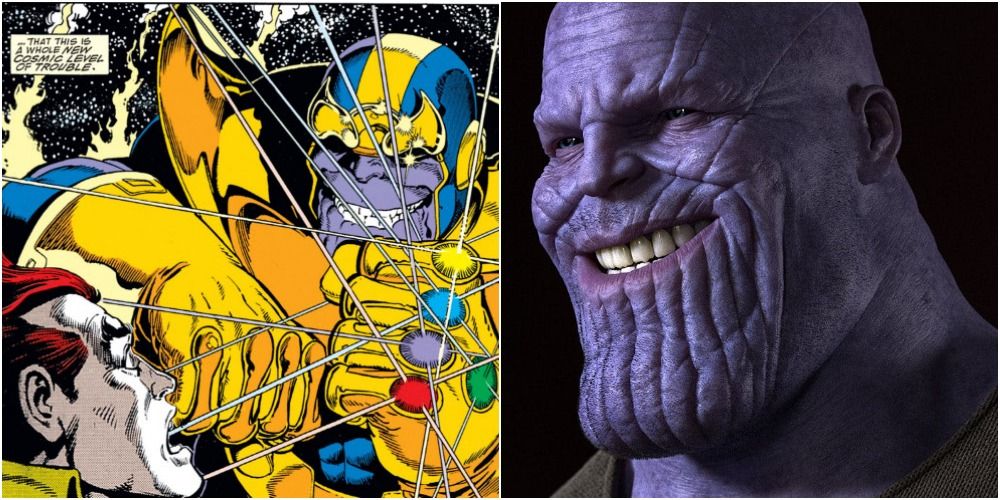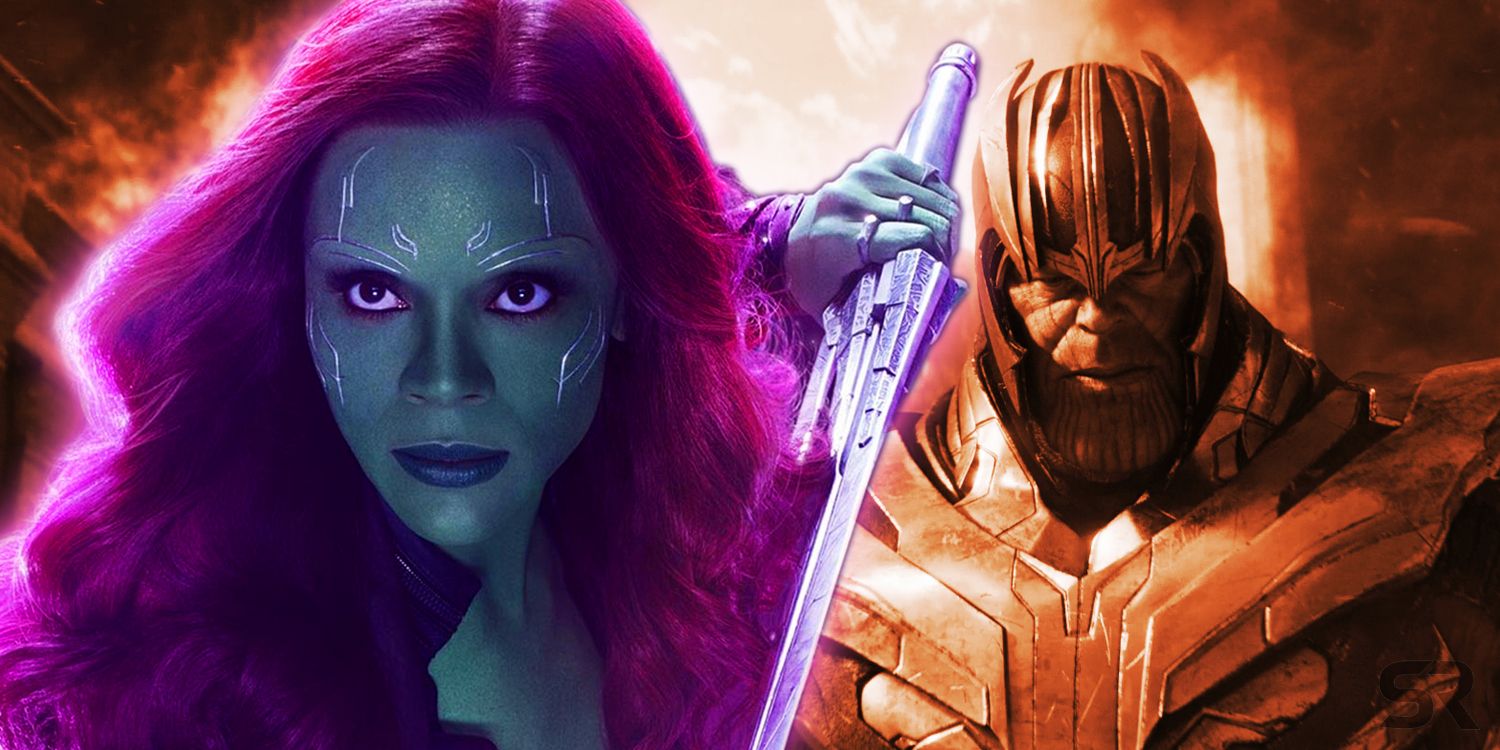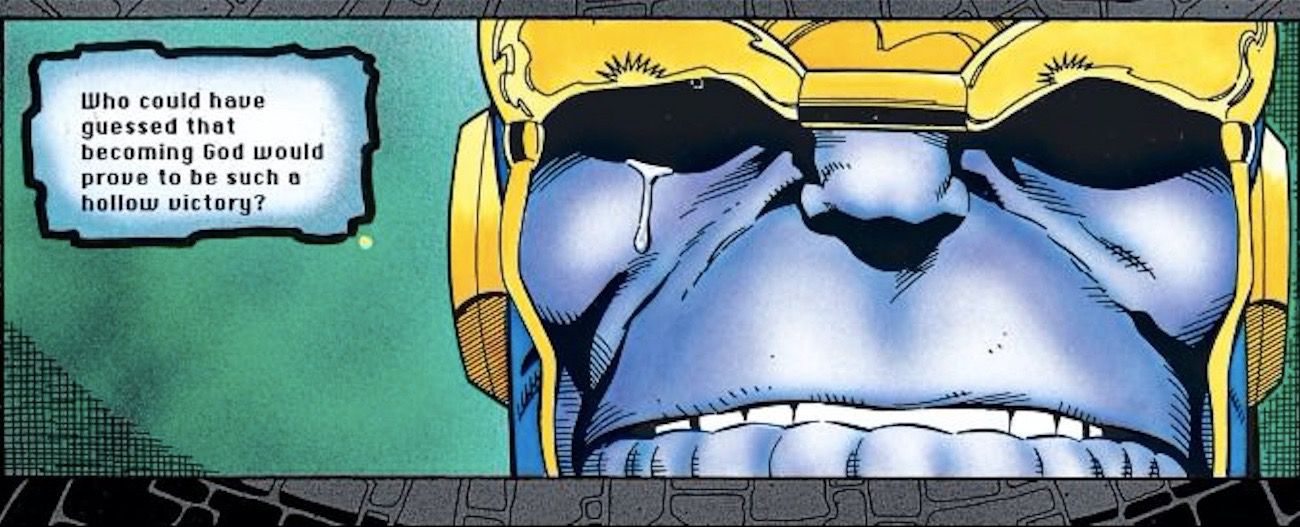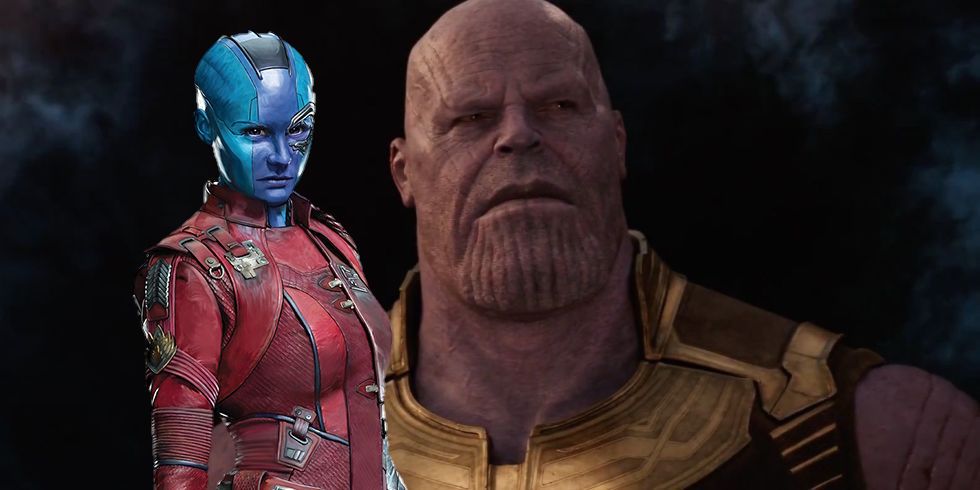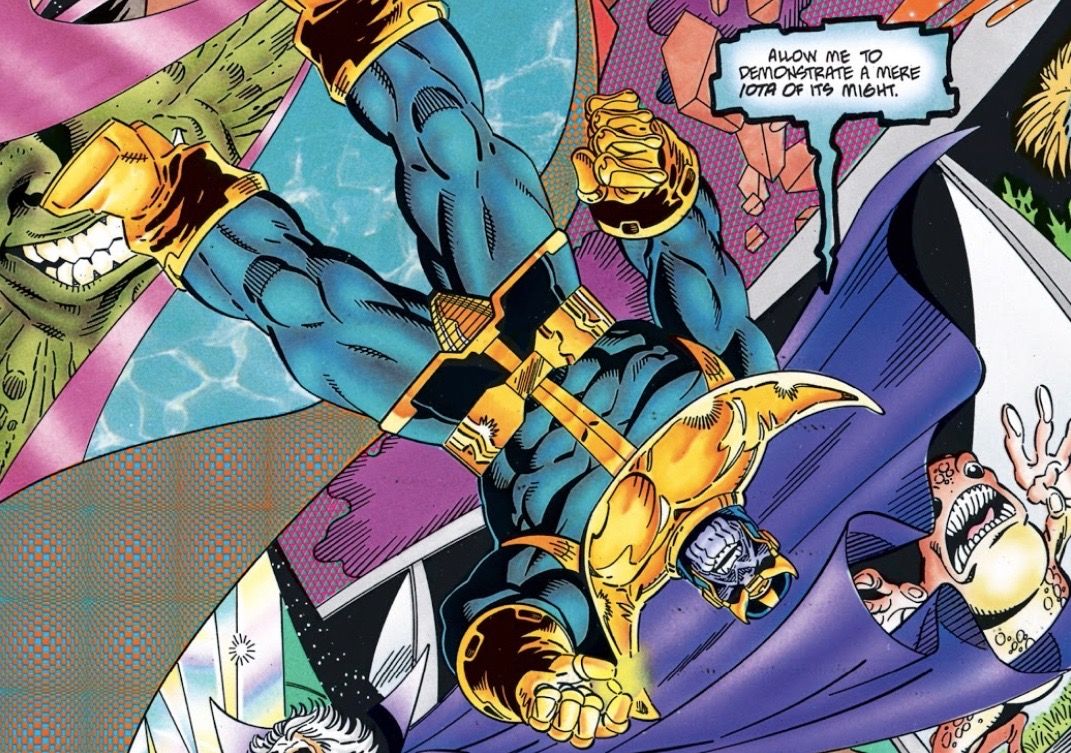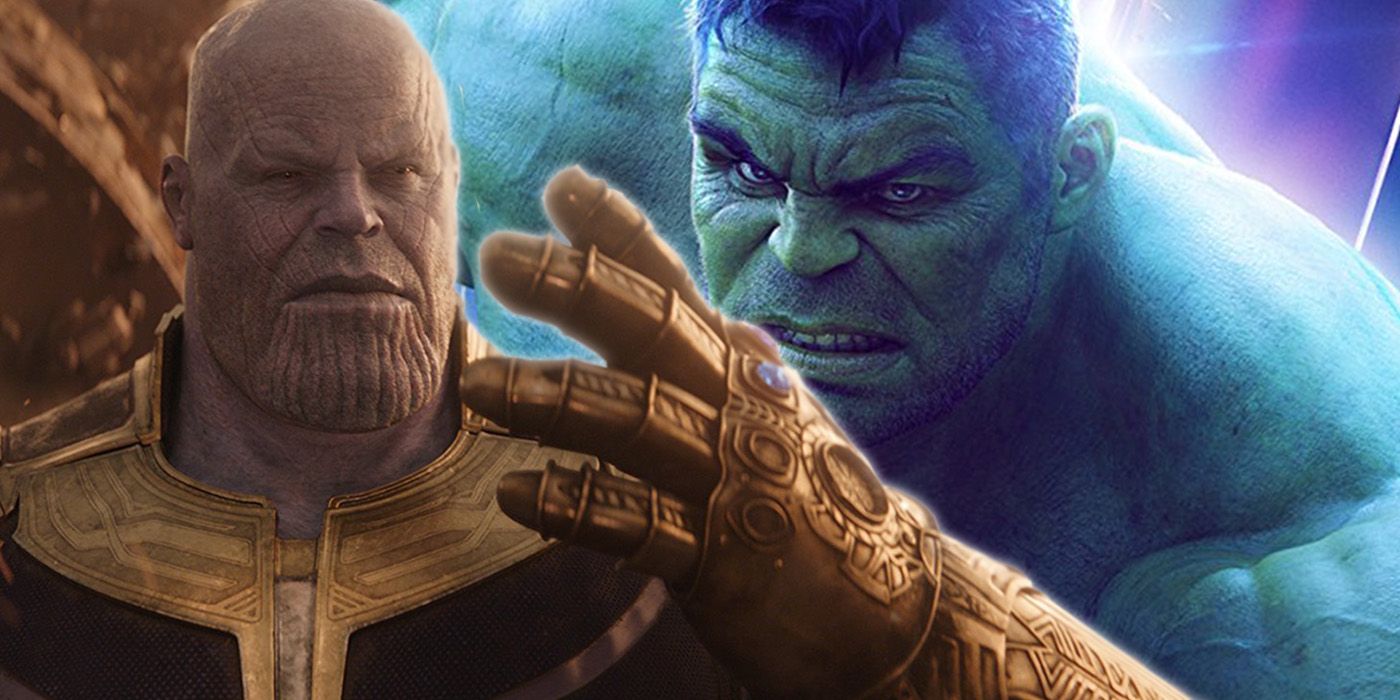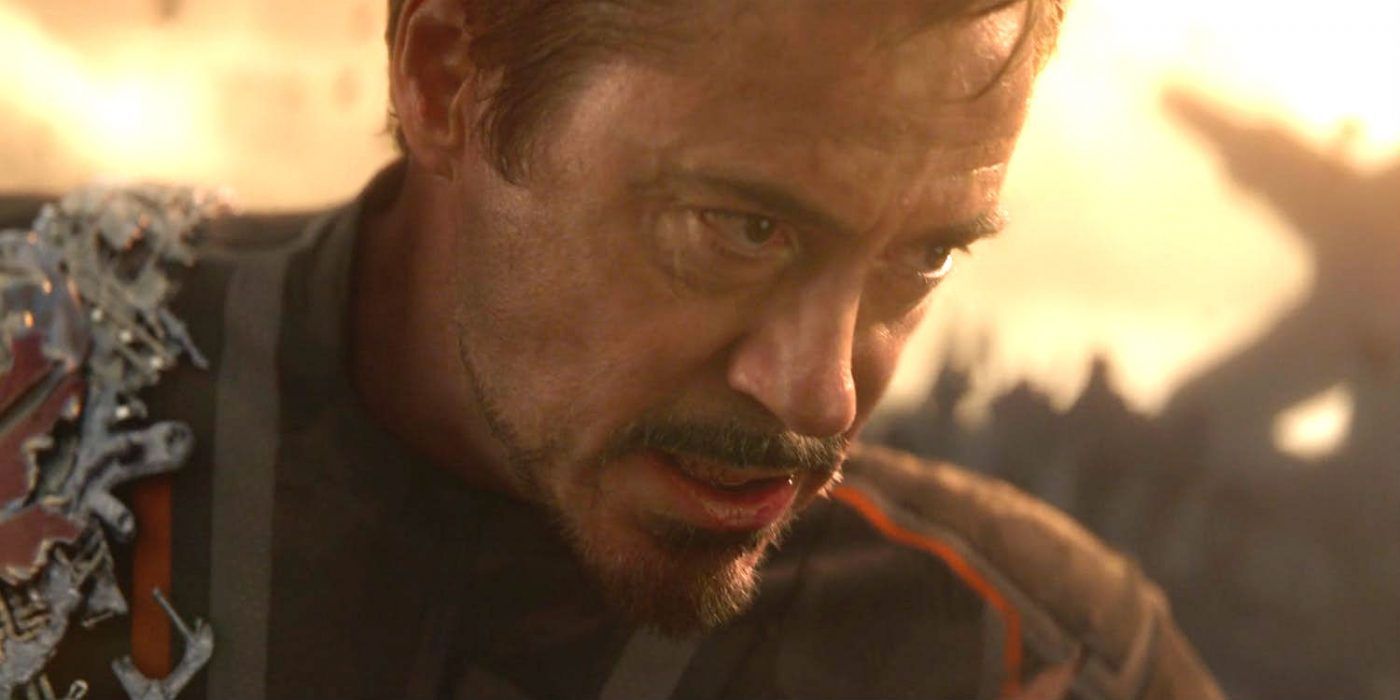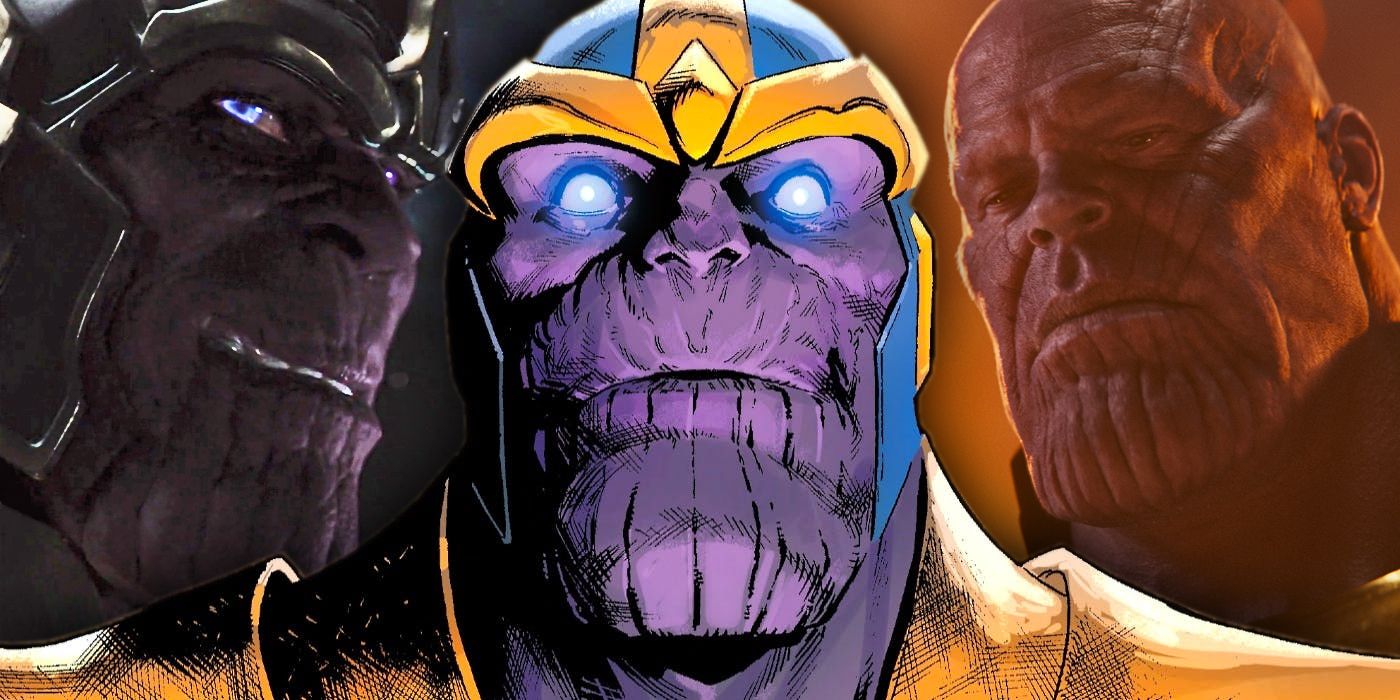Although he may not have had much notoriety a decade ago, the Marvel Cinematic Universe has succeeded in turning the Mad Titan Thanos into one of the most talked-about comic book villains to ever grace the silver screen. This surge in popularity is courtesy of Avengers: Infinity War -- an amalgamation of the last 10 years and 18 movies within the franchise, which finds the Avengers teaming up alongside the Guardians of the Galaxy to try and stop Thanos from acquiring all six Infinity Stones.
While moviegoers got their first indication that Thanos was seeking out the stones ever since 2012’s The Avengers, the Mad Titan's fascination with the Infinity Stones (or Gems) has stretched back for decades within the comics. While Infinity War largely stands on its own two legs story-wise, limited-issue comics like The Thanos Quest and The Infinity Gauntlet no doubt served as inspiration for the filmmakers.
These comics, along with a number of others written by creator Jim Starlin, paint a quintessential portrait of the complicated alien terrorist known as Thanos. Popular opinion (and staggering box office success) tell us that the MCU largely succeeded in fleshing out their most formidable villain to date. But much like the Mad Titan himself, we know there's a little bit of good and bad in everything.
Here are 7 Things The MCU Got Wrong About Thanos (And 8 It Got Right).
15. Right: He’s appeared in multiple movies
The one upside of Thanos emerging victorious at the end of Infinity War, is that he’ll get to take center stage in the upcoming Avengers movie as well. After all, if Infinity War succeeded in anything, it was in leaving the audience wanting more of the Mad Titan.
This is one of the many instances where the MCU has listened to the critics and adjusted its films accordingly. Just as Thor was given a makeover with Ragnarok following two of the franchise's weaker films, the MCU also been doing a better job of fleshing out its villains in recent years.
Just look at the Vulture in Spider-Man: Homecoming — who is imprisoned rather than eliminated by the film’s end. Or Killmonger in Black Panther — who has a fully-realized backstory and a personal goal that is far more interesting than bringing about destruction. Not to mention that Red Skull finally made his long-awaited return in one of Infinity War's more interesting scenes.
While Thanos’ backstory could definitely use some more exploring, the fact that he wasn’t eliminate at least makes this a possibility in future films. Not only does keeping a character around longer make for a more interesting arc, it makes the story a lot closer to the comics, where Thanos has served as everything from the universe’s greatest threat to the Avengers’ most valuable asset.
14. Wrong: His underdeveloped backstory
Although Thanos popped up in a few MCU movies before Infinity War, his total screen time was around a measly four minutes — hardly enough time to develop a proper villain. Therefore, audiences were reasonably worried that Thanos would once again be given short shrift in the latest Avengers outing.
Despite the massive cast, the Mad Titan was given his fair share of screen time - and still the character’s origins have still been massively unexplored.
The only glimpse into Thanos’s past is the flashback he has with a young Gamora coupled with the Titan recounting how his home planet faced destruction.
While these instances shed light on Thanos’s motives and his feelings for his adopted daughter, they barely scratch the surface of the Mad Titan’s long and formative life.
For starters, Thanos was actually born to Eternals — a race that actually looks a lot more human than one might expect. However, Thanos was a carrier of the Deviant gene, which caused his physical mutation and resulted in his mother trying to destroy him.
Thanos eventually returns the favor to his mother, which is only a brief glimpse into the villain's disturbing upbringing that will hopefully receive more attention in the upcoming films.
13. Right: His overall appearance
While it’s easy to get hung up on the character’s slight physical alterations between films, it’s also easy to take for granted home close Thanos still looks compared to his comic book counterpart. After all, we’re talking about a giant purple alien with a rippled chin — that could have easily looked ridiculous if not for such well-crafted visual effects.
While the brief glimpse of Thanos we got at the end of 2012’s The Avengers was arguably closer to comic Thanos — with a more prominent jaw and overall ape-like appearance — integrating Josh Brolin’s performance into the character only served to make Thanos’s a much more three-dimensional villain. This is especially true when we consider how many strictly-CGI villains have fallen flat in other superhero movies.
Thanos’s blue and gold armor is a visual that looks like it's been ripped straight from the comics.
Though in Infinity War, the character makes the conscious decision to shed his suit of armor after acquiring a few stones — displaying how much closer he is to becoming a god despite appearing more vulnerable.
While Thanos is often compared to DC’s Darkseid in appearance, you might be surprised to know that creator Jim Starlin originally took a lot from another DC New Gods' character, Metron, which helps explain how Thanos got his iconic throne and suit of blue armor.
12. Wrong: He continues to use lackeys
During the mid-credits sequence of Avengers: Age of Ultron, Thanos donned the Infinity Gauntlet for the first time on the big screen, declaring “Fine, I’ll do it myself.”
While this scene didn’t make a whole lot of sense being attached to Ultron — a movie where the villain has absolutely no connection to Thanos — it did serve as a reminder to the audience that the Mad Titan was still seeking the Infinity Stones.
In both the original Avengers and Guardians of the Galaxy, Thanos uses Loki and Ronan to try and obtain the Mind and Power Stone. Both power-hungry villains end up using the gems to enact their own personal goals, failing Thanos and themselves in the process.
Thus, it appeared as though Thanos was done using lackeys. After all, he does obtain the six stones of his own volition in The Thanos Quest.
Unfortunately, Thanos doesn’t abide by his own words at the end of Ultron, and he utilizes the Black Order and an army of Outriders throughout Infinity War.
The contradiction to the end of Ultron is less of a problem, and more so the addition of extra villains in a movie that was already overflowing with characters. This undoubtedly took more screen time away from Thanos, not to mention that it once again undermined his own capabilities.
11. Right: He succeeds
Although the story is still largely told from the heroes' perspectives, by the film’s end, it’s Thanos who is given the hero’s ending. While this made for a rather downbeat conclusion, this is effectively what audiences have been asking for out of the MCU for years.
The franchise has been notorious for writing off its villains after a single film — never letting them develop into the complex characters that are the series' heroes - with the exception of Loki, of course. This not only leads to plenty of missed opportunities story-wise, but it flies in the face of everything we’ve learned from the comics, where heroes and villains continuously bounce from one story to the next.
While Thanos is far from unbeatable in the comics, he's certainly one of the more formidable threats in the Marvel Universe. Therefore, his current victory is not only more realistic, but also raises the stakes of the whole franchise. It proves once and for all that major characters are not immortal and that the Avengers and Guardians are far from invincible.
We only hope that the effects of Thanos's victory have lasting consequences beyond the next Avengers film and that things aren't completely undone courtesy of the Infinity Stones.
10. Wrong: His motivations for destroying half the population
In The Infinity Gauntlet, Thanos’s whole reason for wanting to destroy half the universe’s population is because he is trying to court Death. Here, death isn’t just an abstract concept, but a living embodiment that also happens to be Thanos’s unrequited love interest.
He pines over his lady love and believes that the only way toward winning her heart is to cause as much pain and destruction as possible. However, even when he snaps his fingers and disappears half of all life in the universe, she continues to give Thanos the cold shoulder.
While personifying mortality may have been a bit too intense for the MCU, this set-up gives a bit more credence to Thanos’s actions.
Love makes people do crazy things, especially when they believe that these actions will earn them what their heart has long desired.
In Infinity War, Thanos's motivations are much more logically sound. Here, he believes that eliminating half the population will save the universe in the long run by preserving its resources. These environmental worries have been echoed in previous films as we've seen Tony Stark spearhead a shift toward clean energy, while also watching what unchecked waste disposal can do to a planet like Sakaar.
Despite Thanos's motives being more grounded in reality, many missed the twisted love story that inspired Thanos' destructive streak in the first place.
9. Right: His twisted sense of humor
Much like Negan in The Walking Dead and the Joker in The Dark Kight, Thanos is another uber-villain whose actions may be reprehensible, but his charisma is undeniable. It’s not hard to see why other evil-doers would flock to serve the Mad Titan. Unlike a number of other MCU villains, he’s not afraid to crack a smile or admit that he has admiration for those who oppose him.
In the comics, the gauntlet not only serves as a tool with which to destroy the universe, it helps to amplify the Mad Titan’s personality — putting his twisted sense of humor on full display.
In The Infinity Gauntlet, Thanos uses the Reality Gem to toy with a number of his most formidable adversary before bringing about their demise. He turns Gamora into a zombie, removes the mouth from his brother Eros, and turns the God of Thunder into a glass statue.
Suffice it to say, things can get a little weird in the comics when Thanos gets his hands on the Infinity Stones. Thankfully, the filmmakers weren’t afraid to make things equally bizarre in the film, where Thanos dices up Drax and unspools Mantis without a moment's hesitation, all before turning Star-Lord's bullets into bubbles when the hero is at his most despondent.
8. Wrong: His lack of nihilism
Throughout his time in the comics, Thanos is often referred to as a nihilist. He even inadvertently spawns a sect of follows in The Infinity Abyss whose sole desire is to witness the destruction of existence.
Nihilism is a philosophy that centers around the belief that all of life is meaningless, and that the moral principals of right and wrong are simply social constructs. Thanos has even quoted Fredrich Neitzche on a number of occasions. In fact, both Nietzsche and Thanos were known to be at odds with their mothers, where Thanos’s went so far as to try to destroy her son after discovering he carried the Deviant gene.
Being so far at odds with the person who is responsible for your upbringing can no doubt cause a breakdown in morals as well as existential dread. It’s this constant questioning about the meaning of life that makes Thanos and Adam Warlock such an interesting duo on the page.
However, Thanos in Infinity War is far from a nihilist. Instead of wanting to decimate half of the population to satisfy his own needs, Thanos wants to do it to preserve the universe’s resources.
While it’s understandable that the filmmakers wouldn’t want to highlight Thanos’s more depressing personality quirks on the big screen, these feelings of meaninglessness are part of what makes Thanos so compelling on the page.
7. Right: His love for Gamora
One of the biggest criticism of Infinity War is that many of the major character developments in previous films were either put on the back burner or ignored altogether. For instance, Thor losing his eye and hammer in Ragnarok symbolized the God of Thunder taking on the role of his father once and for all - but that was quickly undone courtesy of Rocket Raccoon and Eitri the Dwarf. Likewise, the complicated relationship between Bruce Banner and Natasha Romanoff got condensed to an awkward “hi” despite Bruce being MIA for years.
With a movie as ambitious as Infinity War, we understand that certain arcs are going to have to be put on pause for the ones that better serve the story.
Luckily, one of the most consistent developments that carried through Infinity War involved the relationship between Thanos and his favorite daughter Gamora.
Though much of his past has gone unexplored, the flashback where Thanos adopts a young Gamora was almost enough to turn the Mad Titan into somewhat of a sympathetic villain. This makes the scene on Vormir pack an even bigger emotional punch when he must sacrifice Gamora to obtain the Soul Stone — proving once and for all that Thanos really does love her.
This is a love that Thanos also feels for Gamora in the comics, and the two have even worked side-by-side to save the universe on a number of occasions since Thanos lost his taste for universal domination.
6. Wrong: His lack of self-doubt
On the surface, Thanos comes across as the cockiest, most self-assured being in existence. This is hardly unusual for a comic book villain. What actually sets the Mad Titan apart from a number of his peers is the overwhelming anxiety and self-doubts he has any time he seeks to carry out one of his destructive plans.
Not only does this make for a more interesting character, but it’s also a lot more realistic. After all, most bullies and individuals who claim one hundred percent assurance are often compensating for feelings of inadequacy.
Unfortunately, his doubts and existential dreads are largely missing from the MCU’s incarnation.
In the final shot of the film, Thanos looks to have a moment of hesitation, but whether he feels regret over sacrificing his favorite daughter or half of the universe remains to be seen.
Hopefully, these character traits will continue to be explored in the next Avengers movie, as they are often what lead to Thanos's defeat in the comics. For instance, the only reason Thanos is stopped in The Infinity Gauntlet is that he knows he is unworthy of such magnificent power. Therefore, he subconsciously leaves a hole in his plans so someone more honorable can sweep in and put him in his place.
5. Right: His hate for Nebula
Thanos’s glaring love for Gamora has also paved way for another relationship dynamic that’s been a big part of the comics: his hate for Nebula.
In The Infinity Gauntlet, Nebula isn’t actually Thanos’s adopted daughter, but his alleged grand-daughter for whom Thanos feels only bitter contempt. After Thanos obtains all six Infinity Gems, he transforms Nebula into a zombie, deeming her his greatest creation yet as she is forced to watch him endlessly rule the universe while being able to do nothing to stop him.
While Thanos doesn’t get a chance to zombify Nebula in Infinity War, he does subject her to an extreme amount of bodily pain — turning her life into a bargaining chip so Gamora will lead him to the location of the Soul Stone.
In the comics, it’s ultimately Nebula who snatches the Gauntlet from Thanos’s hand after the Mad Titan’s consciousness becomes one with the universe. Her first task at hand it to undo the damage that Thanos did to her, though the time she spent as a zombie doesn't exactly make her the best fit to wield the gauntlet either.
Considering that Nebula was one of the few spared by her father's destruction in Infinity War, we'd be surprised if she didn't play a vital role in undoing her father's actions in the next Avengers film.
4. Wrong: He lacks mastery over the stones
In the comics, Thanos learns everything there is to know about the Infinity Gems by staring into the Infinity Well. In other words, he seems to have mastery over the gems before he ever sets out to collect them.
When the Mad Titan trades the Collector for the Reality Gem in The Thanos Quest, he uses it to completely warp their reality without a moment’s hesitation. This comes as a horrific shock to the Collector, who failed to unlock the potential of the Reality Gem while it was in his possession, despite being one of the oldest and wisest living beings in the universe.
In Infinity War, Thanos never seems like he’s using the stones to their full potential — especially when his Gauntlet is only one Stone short.
While the powers of each Stone have been nerfed to make for a more interesting story, there are a number of instances when Thanos flat-out doesn’t use the Infinity Stones. These instances almost result in the Gauntlet being removed from his hand on Titan, or Thor almost destroying him with Stormbreaker in Wakanda.
Thanos even seems to destroy the gauntlet by the film's end -- something that only happens to novices who try to wield the Stones in the comic.
Of course, the easy answer to these story imperfections is that they make for a more interesting fight between the heroes and Thanos -- even if it makes Thanos look a bit less intelligent as a result.
3. Right: His incredible strength
What makes Thanos such a formidable opponent is that he’s still one of the most intelligent and powerful villains the Avengers or Guardians have come up against - even when he’s without the Gauntlet.
In the comics, the full magnitude of his physical power remains unknown, as Thanos’ strength has been increased on a number of occasions — whether it be through cosmic intervention or his own scientific doing. Even the Nova Corps once deemed him a universal threat.
Speaking of the Nova Corps, Thanos destroys Xander and obtains the Power Stone before he’s ever introduced in Infinity War. Despite already having the Power Stone, Thanos seems to take on the Hulk using nothing but his own strength, and his annihilation of one of the strongest Avengers mere minutes into the film firmly established the physical menace that is Thanos.
This plays out in a similar fashion in The Thanos Quest, where Thanos is tasked with taking on the Champion — an Elder of the Universe who has godlike strength — in order to obtain the Power Gem. While Thanos can hold his own against the Champion for a time, it's ultimately his intelligence coupled with his brute force that wins him the fight, which could have also been the case during his victory against the Hulk.
2. Wrong: The story is still told from the hero’s perspective
Throughout the Infinity Gauntlet’s time in the comics, Thanos isn’t just one of the primary villains that the heroes are up against - he’s also the story’s central character.
In the two-issue lead up to The Infinity Gauntlet, we watch as Thanos prepares to wipe out half the universe’s population at the behest of his lady love. After staring into her Infinity Well, Thanos learns the true nature of the Infinity Gems and sets out to collect them from each cosmic owner, knowing that they will allow them to complete his destructive task almost instantaneously.
In the comics, we get a front row seat to Thanos’s motives, plans, and inner dialogue.
In a lot of ways, The Thanos Quest plays out like a heist movie where we are forced into the perspective of the criminal. Thus, a large part of the fun is finding out if his plans will succeed.
In a lot of ways, this is lacking in Infinity War. While the movie does a better job of helping us understand the character's motivations, we never really get a behind-the-scenes look at Thanos strategizing and assessing every possible outcome of his plan.
While its understandable for the MCU to continue to highlight its well-established heroes, by not giving us a more in-depth look at how Thanos's mind works, we're never truly in awe of his intelligence or cunning nature.
1. Right: He’s not actually mad
Despite his name, the Mad Titan isn’t all that mad in the comic books. Even when things don’t go according to plan, Thanos is actually fairly even-tempered and able to keep his cool, which gives him time to logically adjust his strategy to help regain the upper hand.
The worst thing that the filmmakers could have done is give us another crazy villain who is overflowing with brute force and little thought.
This is exactly what we got out of some of the weakest MCU villains to date, including Thor: The Dark World’s Malekith and The Incredible Hulk’s Abomination.
From the few scenes we had of Thanos before the Infinity War footage started to come out, the character could have very well continued to be nothing but a physically imposing threat who angers at the slightest sign of something not going his way. This was largely how the character was painted during his interactions with Ronan in Guardians of the Galaxy.
Luckily, Infinity War gave us a much more cerebral character who never seems to lose his cool or hatch utterly insane plans. In fact, Thanos is one of the most logical MCU villains to date, as he seeks to preserve the universe for future generations — even if his methods are a bit on the unorthodox side.
--
What do you think the MCU got wrong and right about Thanos in Avengers: Infinity War? Let us know!

